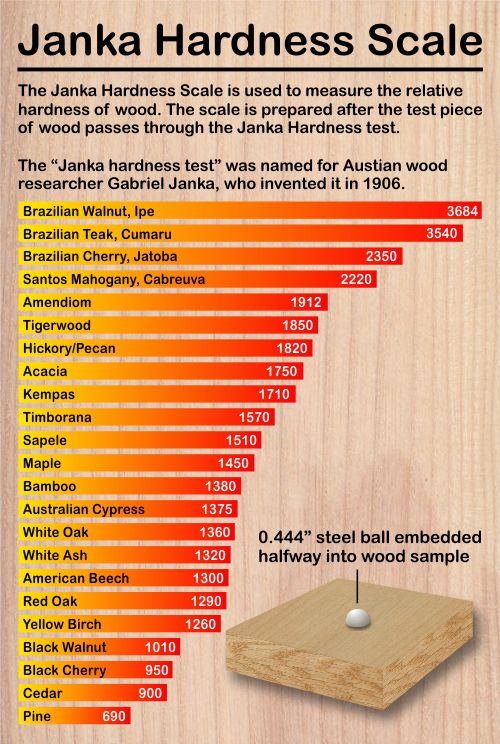Back to Flooring Products
Janka Test and Hardwood Floor Hardness Explained

Understanding the hardness of wood may seem like a specialised topic, but it's crucial for anyone considering or evaluating hardwood floors. This guide will help you learn more about wood floor hardness and the popular Janka hardness scale. Whether you're a flooring novice or an enthusiast, this resource equips you with the knowledge to make informed decisions about timber hardness with ease.
Why Wood Floor Hardness is Important?
Let’s start by mentioning that real wood floors are made out of different domestic and exotic wood species, but you probably already know that. No matter if it comes to engineered wood, solid wood, or parquet, there will be different wood species used for the manufacturing of your floor and each of them has its own specifics. Besides the appearance, colour, undertones, and natural pattern, wood species mostly differ in their natural hardness. When you are investing in a real wood floor, you definitely want one that can last for decades, for as long as possible.
Despite the fact that the durability and long-lasting power of your floor are definitely not entirely defined by the wood species’ hardness, the hardness factor is definitely a very important one in this case. In addition, the hardness of the wood species will determine how the floor will age and "behave" throughout the years. Wood’s hardness is also a factor that dictates how the floor will be maintained properly. Considering all these aspects wood species’ hardness is essential for, it is important to know the hardness of your floor before you choose to buy it.
The Janka Hardness Scale
The Janka hardness scale is the wood floor industry’s way to describe and define the hardness of different wood species. The scale is now widely used as the standard for measuring and ranking wood’s hardness. It is good to know where different wood species sit on the scale before you make a purchase and base your final decision partially on the wood’s ranking on the hardness scale too. The Janka hardness scale is easy to understand and find online or through your local wood floor service contractor. The whole work is already done for you by the specialists, all you need to do is check the ranking system. In a nutshell, the higher the number given by the Janka test to wood species is, the harder this wood species is.
The Janka hardness test measures the side hardness measure of the force required to embed a .444-inch steel ball to half its diameter into the wood. The measure not simply rates different wood species by their hardness but also shows how stress-proof wood is and how different wood species can withstand pressure, denting, and wear. It is a scale that helps you decide on what wood species’ durability fits your household, working space, or lifestyle, in general, the best, whether or not your project will benefit more from very hard and durable wood, or a more flexible and softer choice will be better. The scale also is a good indicator of how harder and softer wood species can be sawed, nailed, installed, sanded, and maintained.
Is the Janka Scale the Only Thing to Consider?
Of course not, the Janka hardness scale should not be the only or main factor that determines your hardwood floor choice. The measure can only be used as a general guide since your wood flooring choice will not based solely on the wood species’ hardness. The measure simply helps you compare different wood species and understand what will fit your lifestyle and the requirements of the space where the floor is installed better. In addition, the Janka test results may vary for a single type of wood, mainly depending on where it is harvested. Furthermore, the construction of the plank, the type of wood flooring, and the floor finish used will further determine and affect the wood’s hardness and durability. Having that all said, the majority of the popular and common wood species used for manufacturing domestic and commercial wood floors are durable and hard-wearing enough to withstand everyday use and last for decades. So no matter how wood is measured by the Janka test, it is safe to say that whatever you choose, you won’t regret it and enjoy it for a long time. Just make sure to take proper and regular care.
Softwoods and Hardwoods in the Context of Wood Flooring Hardness
Wood species are categorised into two main groups – softwoods and hardwoods. It is a popular opinion that hardwoods are harder, more durable, and longer-lasting than softwoods, hence the name. However, this is not necessarily the truth. In the same way, there are hardwoods scoring pretty low on the Janka scale, there are also softwoods that score pretty high ranking. However, the woods occupying the top of the Janka scale are hardwoods, exotic ones to be more specific, because domestic hardwoods are usually less hard.
Hardwoods do not derive their name just because of the fact they are harder wood species. Hardwoods are sourced from trees that are identified as dicot species, or plants with seed with two embryonic leaves. Softwoods are coming from angiosperms, which are plants with seeds that are unenclosed. Enough with the biology class, the only reason you want to make a difference between hardwoods and softwoods is in order to know and decide what wood species you like and need for your hardwood floor. Remember, just because you choose softwoods, it does not mean that the floor won’t be durable and hard-wearing enough since many softwoods have an equivalent score on the scale to many popular and common hardwoods. In addition, hardwood is not always the best choice because some projects and specific indoor conditions require more flexible and softer wood species that easily adapt to their environment.